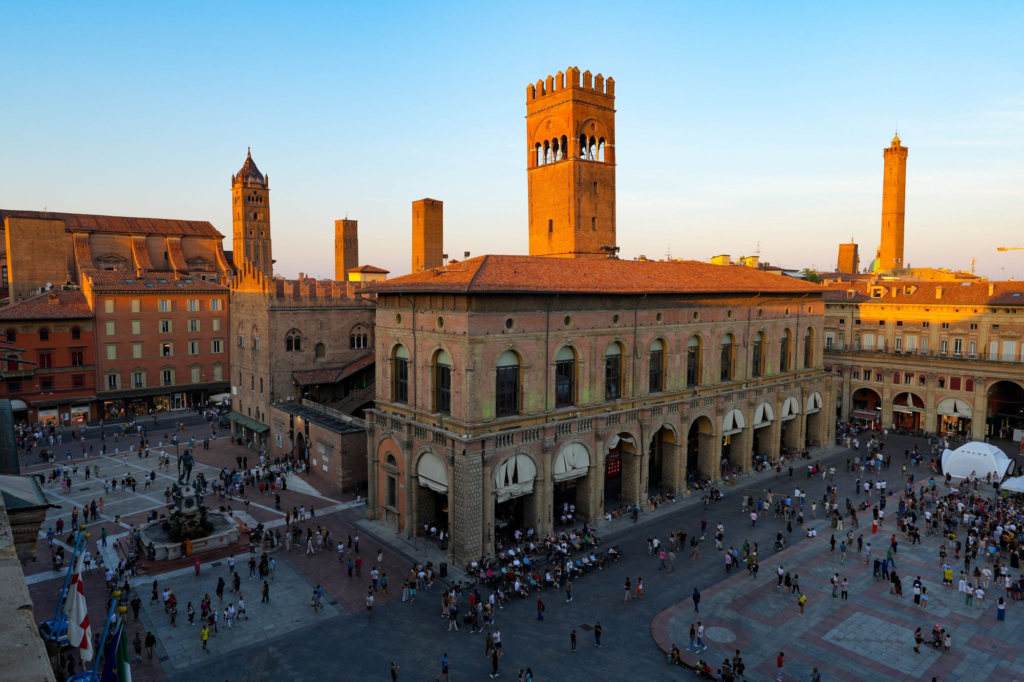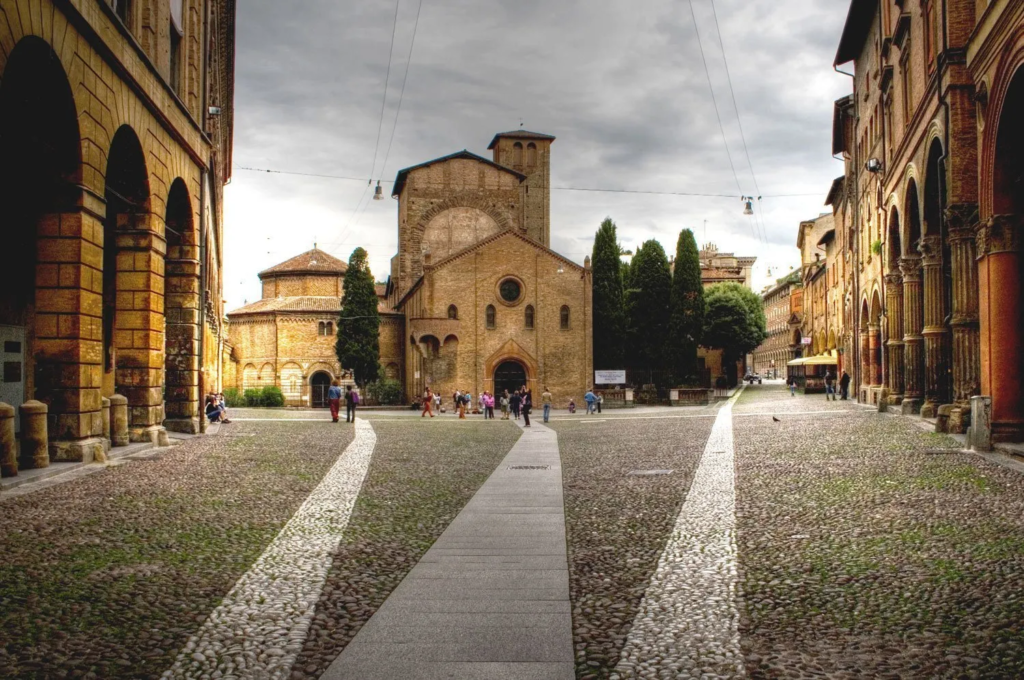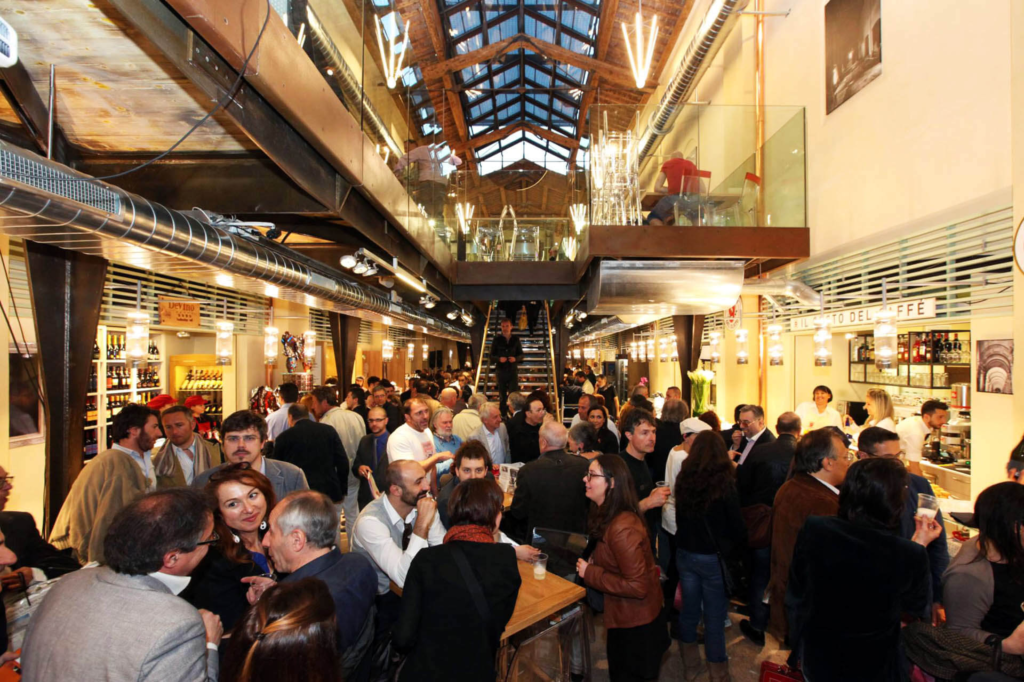Bologna, the capital of Italy’s Emilia-Romagna region, is a city rich in history, culture, and culinary delights. Known for its medieval towers, ancient university, and mouthwatering cuisine, Bologna offers a blend of old-world charm and modern vibrancy. If you’re planning a trip to this enchanting city, here are the top five places you absolutely must visit.
1. Piazza Maggiore: The Heart of Bologna

Piazza Maggiore is the beating heart of Bologna, a grand square that has been the center of the city’s social and political life for centuries. Surrounded by some of Bologna’s most important buildings, including the Basilica di San Petronio, Palazzo dei Notai, and Palazzo del Podestà, this expansive square offers a glimpse into the city’s rich history.
Strolling through Piazza Maggiore, you’ll feel the weight of history as you walk on cobblestones worn smooth by centuries of foot traffic. The square is always bustling, whether it’s with locals sipping espresso at one of the many cafés, tourists marveling at the architecture, or street performers adding a touch of vibrancy to the scene.
Don’t miss the chance to explore the Basilica di San Petronio, one of the largest churches in the world. Although its façade remains unfinished, the interior is a masterpiece of Gothic architecture, with stunning frescoes and a meridian line that dates back to the 17th century. After exploring the basilica, take a moment to relax at one of the nearby cafés, where you can enjoy a traditional Bolognese aperitivo while soaking in the atmosphere of this iconic square.
2. The Two Towers: Asinelli and Garisenda

No visit to Bologna is complete without seeing the city’s famous Two Towers, the Asinelli and Garisenda. These medieval towers are among the few remaining from the dozens that once dotted the cityscape during the 12th and 13th centuries. The Asinelli Tower, standing at 97.2 meters, is the tallest leaning medieval tower in the world and offers an unparalleled view of Bologna from its summit.
Climbing the 498 steps to the top of the Asinelli Tower is a must-do for any visitor. As you ascend, you’ll pass through narrow wooden staircases that creak with history, and when you reach the top, you’ll be rewarded with a breathtaking panoramic view of Bologna’s red-tiled rooftops and the surrounding countryside.
The Garisenda Tower, though shorter at 48 meters, is equally fascinating. Its pronounced tilt makes it a unique architectural wonder. While you can’t climb this tower, its proximity to the Asinelli offers a striking contrast, and the two together create a quintessential Bolognese postcard image.
3. Archiginnasio of Bologna: A Historical Treasure

The Archiginnasio of Bologna, once the main building of the University of Bologna, is a must-visit for history buffs and architecture lovers alike. Founded in 1088, the University of Bologna is the oldest university in the world, and the Archiginnasio served as its main lecture hall for over 300 years.
The building itself is a masterpiece of Renaissance architecture, with its grand portico, intricate frescoes, and the impressive Teatro Anatomico, an ancient anatomical theater where medical students once studied human anatomy through dissections. The theater, with its wooden carvings and marble statues, transports you back to the 17th century, offering a unique insight into the history of medical education.
Wander through the building’s hallways, where you’ll find the walls adorned with thousands of coats of arms belonging to students who attended the university over the centuries. The Archiginnasio Library, home to a vast collection of rare books and manuscripts, is another highlight, offering a quiet retreat for those who wish to immerse themselves in Bologna’s academic heritage.
4. Santo Stefano: The Seven Churches

The Basilica di Santo Stefano, often referred to as the “Seven Churches,” is a complex of religious buildings that date back to the 5th century. Originally designed to mimic the Church of the Holy Sepulchre in Jerusalem, the complex was once composed of seven churches, but today, only four remain.
Each of the surviving churches has its own unique charm. The Church of the Crucifix, with its simple yet evocative interior, houses a 14th-century crucifix and a crypt that is said to hold the remains of Saint Petronius, Bologna’s patron saint. The Church of the Holy Sepulchre, built on an ancient Roman temple, is a striking example of early Christian architecture, with its circular design reminiscent of the Holy Sepulchre in Jerusalem.
As you explore the complex, you’ll discover a serene courtyard, a peaceful cloister, and an ancient well that adds to the site’s mystical atmosphere. Santo Stefano is a place of contemplation and spiritual reflection, offering a quiet escape from the hustle and bustle of the city.
5. Mercato di Mezzo: A Culinary Journey

No trip to Bologna would be complete without indulging in its legendary cuisine, and the Mercato di Mezzo is the perfect place to do just that. Located in the heart of the Quadrilatero, Bologna’s historic market district, the Mercato di Mezzo is a food lover’s paradise, offering a wide array of local delicacies.
Step inside this vibrant market, and you’ll be greeted by the enticing aromas of freshly baked bread, aged cheeses, cured meats, and handmade pasta. The market is a feast for the senses, with its colorful displays of fruits, vegetables, and artisanal products.
Whether you’re looking to sample traditional Bolognese dishes like tortellini, tagliatelle al ragù, or mortadella, or simply want to pick up some local ingredients to take home, the Mercato di Mezzo has something for everyone. Grab a seat at one of the market’s many eateries, where you can enjoy a plate of pasta made with fresh, local ingredients, paired with a glass of regional wine.
For a true Bolognese experience, visit the market in the morning when it’s bustling with locals doing their daily shopping. It’s the perfect place to immerse yourself in the culinary culture of Bologna and savor the flavors that have made this city famous.
Travel Tips for Visiting Bologna
- Getting Around: Bologna’s city center is compact and best explored on foot. However, if you need to travel further, the city’s efficient bus system and bike-sharing services are excellent options.
- Best Time to Visit: Spring (April to June) and autumn (September to October) are the best times to visit Bologna, offering pleasant weather and fewer tourists.
- Local Etiquette: When dining in Bologna, it’s customary to wait for everyone at the table to be served before starting your meal. Also, don’t be surprised if meals take longer than usual—Bolognese people like to savor their food!
- Language: While many locals speak English, learning a few basic Italian phrases can go a long way in enhancing your experience.
Read more Top 10 Most Visited Cities in Italy








